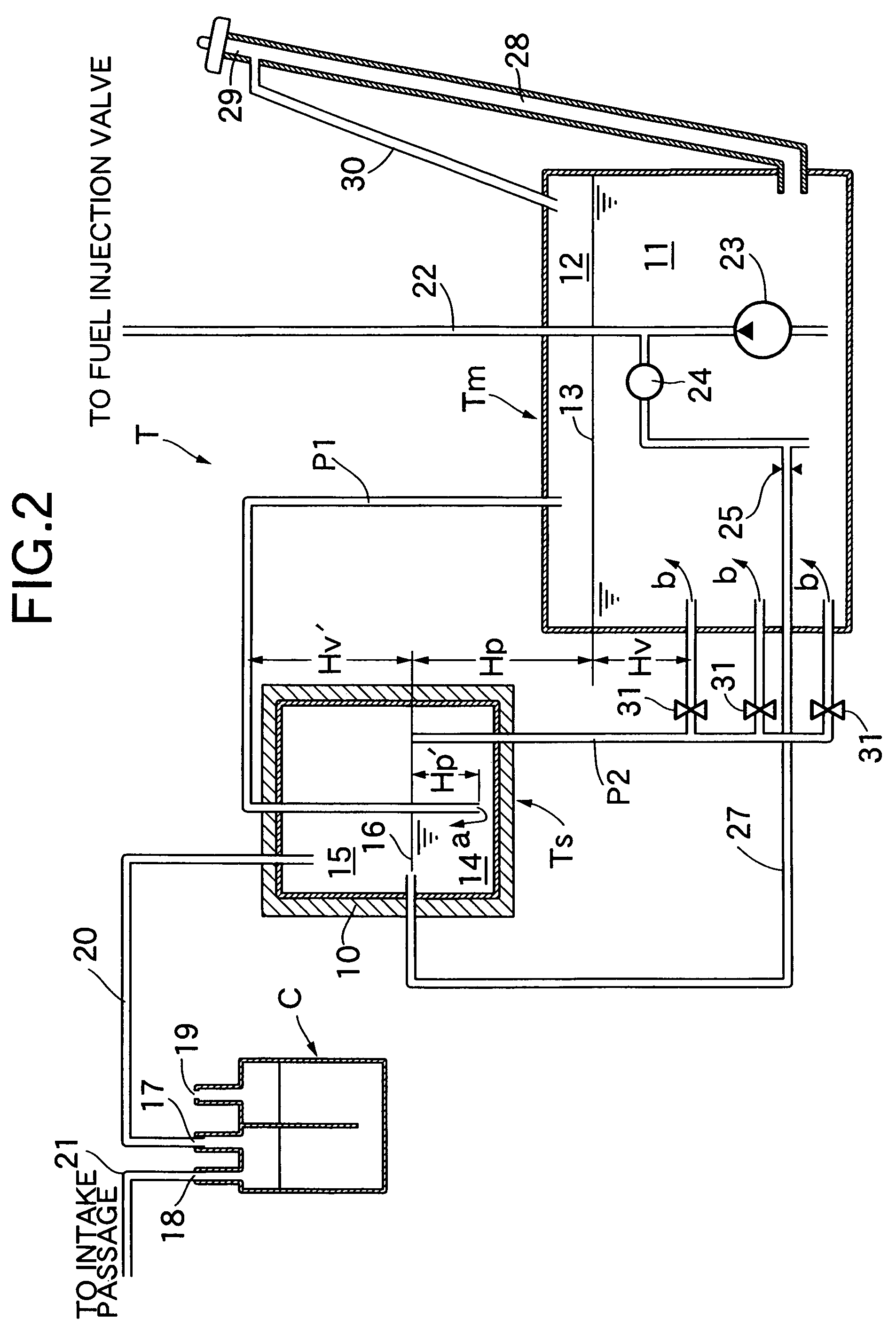Fuel vapor release suppression system for fuel tank
a technology of fuel tank and suppression system, which is applied in the direction of liquid fuel feeders, machines/engines, combustion air/fuel air treatment, etc., can solve the problems of fuel vapor not being liquefied, power consumption of cooling system imposing a burden on the vehicle battery, etc., and achieve the effect of liquefying fuel vapor
- Summary
- Abstract
- Description
- Claims
- Application Information
AI Technical Summary
Benefits of technology
Problems solved by technology
Method used
Image
Examples
first embodiment
[0046]FIG. 1 shows the present invention. A fuel tank T of an automobile includes a main tank Tm and a sub tank Ts. The sub tank Ts, having a volume smaller than that of the main tank Tm, is disposed at a position higher than the main tank Tm. The periphery of the sub tank Ts is covered by a heat-insulating material 10. The interior of the main tank Tm is divided into a liquid-phase portion 11 filled with fuel and a gas-phase portion 12 filled with fuel vapor. When a fuel level 13 in the main tank Tm changes due to replenishment or consumption of fuel, the volume of the liquid-phase portion 11 and the volume of the gas-phase portion 12 change. The interior of the sub tank Ts is divided into a liquid-phase portion 14 filled with fuel and a gas-phase portion 15 filled with fuel vapor. A fuel level 16 in the sub tank Ts is basically constant. The gas-phase portion 12 of the main tank Tm and the liquid-phase portion 14 of the sub tank Ts are connected via a first communication passage P...
second embodiment
[0070]the present invention is now described by reference to FIG. 2.
[0071]As described in the first embodiment, Hv2 while preventing fuel from flowing from the sub tank Ts back to the main tank Tm via the first communication passage P1. However, since the height Hv changes in response to the fuel level 13 of the main tank Tm going up and down, it is difficult to constantly establish Hv
[0072]That is, in order to supply fuel vapor from the gas-phase portion 15 of the sub tank Ts to the liquid-phase portion 11 of the main tank Tm via the second communication passage P2, it is desirable to lower the position of the opening portion of the second communication passage P2 in the main tank Tm as much as possible. However, lowering the position of the opening portion increases the height Hv, thus making it difficult to establish Hv2 in the main tank Tm is raised, there is a problem that the opening portion is exposed above the fuel level 13 when the fuel level 13 goes down, and fuel vap...
third embodiment
[0074]the present invention is now described by reference to FIG. 3.
[0075]In the first and second embodiments, the sub tank Ts is disposed outside the main tank Tm, but in the third embodiment a sub tank Ts is disposed within a main tank Tm. Disposing the sub tank Ts within the main tank Tm reduces the overall size of the entire fuel tank T, reduces the number of steps in assembling the fuel tank T to a vehicle body, and improves the degree of freedom in the layout. Further, since the sub tank Ts, disposed within the main tank Tm, is not susceptible to the influence of the ambient air temperature, it is not necessary to attach the heat-insulating material 10 to the sub tank Ts, as shown in the first and second embodiments.
[0076]Furthermore, it is necessary to make the highest portion of the first communication passage P1 relatively high in order to secure a sufficient height Hv′, leading to a problem that the first communication passage P1 inevitably becomes long. To solve such a pr...
PUM
 Login to View More
Login to View More Abstract
Description
Claims
Application Information
 Login to View More
Login to View More - R&D
- Intellectual Property
- Life Sciences
- Materials
- Tech Scout
- Unparalleled Data Quality
- Higher Quality Content
- 60% Fewer Hallucinations
Browse by: Latest US Patents, China's latest patents, Technical Efficacy Thesaurus, Application Domain, Technology Topic, Popular Technical Reports.
© 2025 PatSnap. All rights reserved.Legal|Privacy policy|Modern Slavery Act Transparency Statement|Sitemap|About US| Contact US: help@patsnap.com



